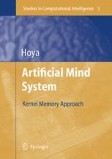Search
Search Results
-
Prototype Based Recognition of Splice Sites
Splice site recognition is an important subproblem of de novo gene finding, splice junctions constituting the boundary between coding and non-coding...
-
Artificial Neural Networks for Reducing the Dimensionality of Gene Expression Data
The use of gene chips and microarrays for measuring gene expression is becoming widespread and is producing enormous amounts of data. With increasing...
-
Computational Complexity of the XCS Classifier System
Learning classifier systems (LCSs) are online-generalizing rule-based learning systems that use evolutionary computation techniques to evolve an...
-
Conclusions
This chapter concludes this monograph. It starts with the summary of the progress, results, and status of the research project, followed by tasks of...
-
A First Improvement: Using Promoters
Harik [47] took Holland’s call [53] for evolution of tight genetic linkage and proposed the linkage learning genetic algorithm (LLGA), which used a...
-
Learning in the AMS Context
In this chapter, we dig further into the notion of “learning” within the AMS context. In conventional connectionist models, the term “learning” is...
-
Two Simple Learning Classifier Systems
Since its introduction Holland’s Learning Classifier System (LCS) [Holland, 1976] has inspired much research into ‘genetics-based’ machine learning...
-
A Mathematical Framework for Studying Learning in Classifier Systems
Massively parallel, rule-based systems offer both a practical and a theoretical tool for understanding systems that act usefully in complex...
-
What Makes a Problem Hard for XCS?
Two basic questions to ask about any learning system are: to what kinds of problems is it well suited? To what kinds of problems is it poorly suited?...
-
Rule Fitness and Pathology in Learning Classifier Systems
When applied to reinforcement learning, Learning Classifier Systems (LCS) [5] evolve sets of rules in order to maximise the return they receive from...
-
Convergence Time for the Linkage Learning Genetic Algorithm
As indicated in the previous chapter, inspired by the coding mechanism existing in genetics, introducing the use of promoters in the linkage learning...
-
Introducing Subchromosome Representations
While the linkage learning genetic algorithm achieved successful genetic linkage learning on problems with badly scaled building blocks, it was less...
-
Basics of Engineering the Hybrid Intelligent Systems – Not Only Industrial Applications
ComputationalIntelligence(CI) is the methodological framework fitting the highly interdisciplinary requirements featuring most real-world...
-
No music without melody: How to understand biochemical systems by understanding their dynamics
The dynamics of the concentration of biochemical species is a systems property that arises through the interaction of metabolites and other...
-
Fuzzy Rules Extraction from Connectionist Structures
In the conjugate effort of building shells for Hybrid Intelligent Systems with a homogenous architecture, based on neural networks, a difficult task...
-
Integration of Explicit and Implicit Knowledge in Hybrid Intelligent Systems
The introduction of modular networks into fuzzy systems provides new insights into the integration of explicit and implicit knowledge in a...
-
Practical Implementation Aspects Regarding Real-World Application of Hybrid Intelligent Systems
This chapter is focussed on the application aspects of HISengineering. The main application areas of HIS are mentioned. A lot of outstanding...
-
Intelligent Techniques and Computational Intelligence
The field of Intelligent Technologies (IT) or Computational Intelligence (CI) is mainly the result of an increasing merger of Fuzzy Systems(FS) or...
-
Neuro-Fuzzy Integration in Hybrid Intelligent Systems
In the last fifteen years, hybrid neural systems have drawn increasing research interest. This approach has been successfully used in various areas,...
-
Neuro-Fuzzy Based Hybrid Intelligent Systems for Fault Diagnosis
In the last ten years, the field of diagnosis has attracted the attention of many researchers, both from the technical area as well as from the...
